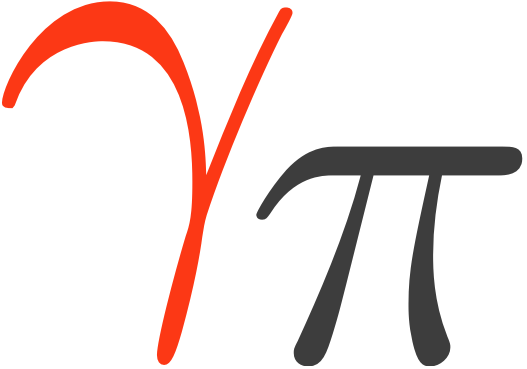Note
Go to the end to download the full example code or to run this example in your browser via Binder.
Fermi-LAT with Gammapy#
Data inspection and preliminary analysis with Fermi-LAT data.
Introduction#
Gammapy fully supports Fermi-LAT data analysis from DL4 level (binned maps). In order to perform data reduction from the events list and spacecraft files to binned counts and IRFs maps we recommend to use Fermipy, which is based on the Fermi Science Tools (Fermi ST).
Using Gammapy with Fermi-LAT data could be an option for you if you want to do an analysis that is not easily possible with Fermipy and the Fermi Science Tools. For example a joint likelihood fit of Fermi-LAT data with data e.g. from H.E.S.S., MAGIC, VERITAS or some other instrument, or analysis of Fermi-LAT data with a complex spatial or spectral model that is not available in Fermipy or the Fermi ST.
This tutorial will show you how to convert Fermi-LAT data into a DL4
format that can be used by Gammapy (MapDataset) and perform a 3D analysis. As an
example, we will look at the Galactic center.
We are going to analyses high-energy data from 10 GeV from 1 TeV (in reconstructed energy).
Setup#
For this notebook you have to get the prepared
fermi-gc data provided in your $GAMMAPY_DATA.
# %matplotlib inline
import numpy as np
from astropy import units as u
import matplotlib.pyplot as plt
from gammapy.catalog import CATALOG_REGISTRY
from gammapy.datasets import Datasets, FermipyDatasetsReader
from gammapy.estimators import TSMapEstimator
from gammapy.maps import Map
from gammapy.modeling import Fit
from gammapy.modeling.models import (
Models,
PointSpatialModel,
PowerLawSpectralModel,
TemplateSpatialModel,
SkyModel,
PowerLawNormSpectralModel,
)
from gammapy.utils.scripts import make_path
Check setup#
We check the setup in this tutorial, as we require specific files to be downloaded to continue.
from gammapy.utils.check import check_tutorials_setup
check_tutorials_setup()
System:
python_executable : /home/runner/work/gammapy-docs/gammapy-docs/gammapy/.tox/build_docs/bin/python
python_version : 3.11.14
machine : x86_64
system : Linux
Gammapy package:
version : 2.0.dev2532+g99dc4a80a
path : /home/runner/work/gammapy-docs/gammapy-docs/gammapy/.tox/build_docs/lib/python3.11/site-packages/gammapy
Other packages:
numpy : 2.3.5
scipy : 1.16.3
astropy : 7.2.0
regions : 0.11
click : 8.2.1
yaml : 6.0.3
IPython : 9.8.0
jupyterlab : not installed
matplotlib : 3.9.4
pandas : not installed
healpy : 1.19.0
iminuit : 2.32.0
sherpa : 4.18.0
naima : 0.10.2
emcee : 3.1.6
corner : 2.2.3
ray : 2.52.1
Gammapy environment variables:
GAMMAPY_DATA : /home/runner/work/gammapy-docs/gammapy-docs/gammapy-datasets/dev
Fermipy configuration file#
Gammapy can utilise the same configuration file as Fermipy to convert
the Fermipy-generated maps into Gammapy datasets. For more information on the
structure of these files, refer to the Fermipy configuration
page. In this
tutorial, we will analyse Galactic center data generated with Fermipy version 1.3 and
the configuration given in
$GAMMAPY_DATA/fermi-gc/config_fermipy_gc_example.yaml:
# Fermipy example configuration
# for details, see https://fermipy.readthedocs.io/en/latest/config.html
# For IRFs, event type and event class options, see https://fermi.gsfc.nasa.gov/ssc/data/analysis/documentation/Cicerone/Cicerone_Data/LAT_DP.html
components:
- model: {isodiff: $FERMI_DIR/refdata/fermi/galdiffuse/iso_P8R3_CLEAN_V3_PSF2_v1.txt}
selection: {evtype: 16} #4 is PSF0, 8 PSF1, 16 PSF2, 32 PSF3
data: {ltcube: null}
- model: {isodiff: $FERMI_DIR/refdata/fermi/galdiffuse/iso_P8R3_CLEAN_V3_PSF3_v1.txt}
selection: {evtype: 32}
data: {ltcube: null}
data:
evfile : ./raw/events_list.lst
scfile : ./raw/L241227031840F357373F12_SC00.fits
binning:
roiwidth : 8.0
binsz : 0.1
binsperdec : 10
coordsys : GAL
proj: CAR
projtype: WCS
selection :
# gtselect parameters
emin : 3981.0717055349733 # ENERGY TRUE for Gammapy
emax : 2511886.4315095823 # ENERGY TRUE for Gammapy
zmax : 105 # deg
evclass : 256 # CLEAN
tmin : 239557417
tmax : 752112005
# gtmktime parameters
filter : 'DATA_QUAL>0 && LAT_CONFIG==1'
roicut : 'no'
# Set the ROI center to the coordinates of this source
glon : 0.
glat : 0.
fileio:
outdir : ''
logfile : 'out.log'
usescratch : False
scratchdir : '/scratch'
gtlike:
edisp : True
edisp_bins : 0 # DO NOT CHANGE edisp_bins will be handled by Gammapy
irfs : 'P8R3_CLEAN_V3'
model:
src_roiwidth : 10.0 # This is used by Fermipy to compute the PSF RADMAX, even if no models are set
The most important points for Gammapy users are:
eminandemaxin this file should be considered as the energy true range. It should be larger that the reconstructed energy range.edisp_bins : 0is strongly recommended at this stage otherwise you might face inconsistencies in the energy axes of the different IRFs created by Fermipy.The
edisp_binsvalue will be redefined later on by Gammapy as a positive value in order to create the reconstructed energy axis properly.If you want to use the
$FERMI_DIRvariable to read the background models it must also be defined in your Gammapy environment, otherwise you have to define your own paths.For this tutorial we copied the iso files in
$GAMMAPY_DATA/fermi-gcand edited the paths in the yaml file for simplicity.
More generally in order to select a good binning it is important to know the instrument resolution, for that you can have a quick look at the IRFs in the Fermi-LAT performance page.
Since the energy resolution varies with energy, it is important to
choose an energy binning that is fine enough to capture this energy
dependence. That is why we recommend a binning with 8 to 10 bins per
decade. The energy axes will be created such as it is linear in log space
so it’s better to define emin and emax such as they align with a log binning.
Here we have as true energy range \(\log(emin) = 0.6 \sim 4\) GeV to
\(\log(emax) = 3.4 \sim 2500\) GeV.
While the reconstructed energy range of our analysis will be 10 GeV to 1000 GeV.
The spatial binning should be of the same order of the PSF 68%
containment radius which is in average 0.1 degree above 10 GeV and
rapidly increases at lower energy. Ideally it should remain within a
factor of 2 or 3 of the PSF radius at most. In order to properly take
into account for the sources outside the region of interest that
contribute inside due to the PSF we have to define a wider roiwidth
than our actual region of interest. Typically, we need a margin equal to the
99% containment of the PSF on each side. Above 10 GeV considering only
PSF2&3 the 99% PSF containment radius is about 1 degree. Thus, if we
want to study a 3 degree radius around the GC we have to take a roiwidth of 8
deg. (If considering lower energies or including PSF0 and PSF1, it should be much
larger).
From Fermipy maps to Gammapy datasets#
In your Fermipy environment you have to run the following commands
from fermipy.gtanalysis import GTAnalysis
gta = GTAnalysis('config_fermipy_gc_example.yaml',logging={'verbosity' : 3})
gta.setup()
gta.compute_psf(overwrite=True) # this creates the psf kernel
gta.compute_drm(edisp_bins=0, overwrite=True) # this creates the energy dispersion matrix
# DO NOT CHANGE edisp_bins here, it will be redefined by Gammapy later on
This will produce a number of files including:
“ccube_00.fits” (counts)
“bexpmap_00.fits” (exposure)
“psf_00.fits” (psf)
“drm_00.fits” (edisp)
In your Gammapy environment you can create the datasets using the same configuration file.
reader = FermipyDatasetsReader(
"$GAMMAPY_DATA/fermi-gc/config_fermipy_gc_example.yaml", edisp_bins=4
)
datasets = reader.read()
print(datasets)
/home/runner/work/gammapy-docs/gammapy-docs/gammapy/.tox/build_docs/lib/python3.11/site-packages/astropy/wcs/wcs.py:918: FITSFixedWarning: 'datfix' made the change 'Set DATEREF to '2001-01-01T00:01:04.184' from MJDREF.
Set MJD-OBS to 54682.655283 from DATE-OBS.
Set MJD-END to 60614.993543 from DATE-END'.
warnings.warn(
/home/runner/work/gammapy-docs/gammapy-docs/gammapy/.tox/build_docs/lib/python3.11/site-packages/astropy/wcs/wcs.py:918: FITSFixedWarning: 'datfix' made the change 'Set DATEREF to '2001-01-01T00:01:04.184' from MJDREF.
Set MJD-OBS to 54682.655283 from DATE-OBS.
Set MJD-END to 60614.993543 from DATE-END'.
warnings.warn(
Datasets
--------
Dataset 0:
Type : MapDataset
Name : P8R3_CLEAN_V3_PSF2_v1
Instrument :
Models : ['isotropic_P8R3_CLEAN_V3_PSF2_v1']
Dataset 1:
Type : MapDataset
Name : P8R3_CLEAN_V3_PSF3_v1
Instrument :
Models : ['isotropic_P8R3_CLEAN_V3_PSF3_v1']
Note that the edisp_bins is set again here as a positive number so
Gammapy can create its reconstructed energy axis properly. The energy
dispersion correction implemented Gammapy is closer to the version
implemented in Fermitools >1.2.0, which take into account the interplay
between the energy dispersion and PSF.
Across most of the Fermi energy range, the level of migration in log10(E)
remains within 0.2, increasing up to 0.4 below 100 MeV,
due to energy dispersion. Therefore, we recommend that the
product of |edisp_bins| and the width of the log10(E) bins be at
least equal to 0.2. For a binning of 8 to 10 bins per decade, this
corresponds to |edisp_bins| ≥ 2. For further information, see
Pass8_edisp_usage.
In our case, we have 10 bins per decade and true energy axis starts
at about 4 GeV, so with edisp_bins=4 the reconstructed energy axis
starts at 10 GeV:
MapAxis
name : energy_true
unit : 'MeV'
nbins : 28
node type : edges
edges min : 4.0e+03 MeV
edges max : 2.5e+06 MeV
interp : log
MapAxis
name : energy
unit : 'MeV'
nbins : 20
node type : edges
edges min : 1.0e+04 MeV
edges max : 1.0e+06 MeV
interp : log
Note that selecting edisp_bins=2 means the reconstructed energy
of the counts geometry will start at \(10^{0.8} \sim 6.3\) GeV.
If we want to start the analysis at 10 GeV in this case, we need to
update the mask_fit to exclude the first 2 reconstructed energy bins.
Considering more edisp_bins is generally safer but requires more memory
and increases computation time.
Alternatively, if you created the counts and IRF files from the
Fermi-LAT science tools without Fermipy you can use the
create_dataset method. Note that in this case we cannot guarantee
that your maps have the correct axes dimensions to be properly converted
into Gammapy datasets.
path = make_path("$GAMMAPY_DATA/fermi-gc")
dataset0 = reader.create_dataset(
path / "ccube_00.fits",
path / "bexpmap_00.fits",
path / "psf_00.fits",
path / "drm_00.fits",
isotropic_file=None,
edisp_bins=0,
name="fermi_lat_gc_psf2",
)
dataset1 = reader.create_dataset(
path / "ccube_01.fits",
path / "bexpmap_01.fits",
path / "psf_01.fits",
path / "drm_01.fits",
isotropic_file=None,
edisp_bins=0,
name="fermi_lat_gc_psf3",
)
datasets_fromST = Datasets([dataset0, dataset1])
# The above was an alternative reading method we don't need those after
del dataset0, dataset1, datasets_fromST
/home/runner/work/gammapy-docs/gammapy-docs/gammapy/.tox/build_docs/lib/python3.11/site-packages/astropy/wcs/wcs.py:918: FITSFixedWarning: 'datfix' made the change 'Set DATEREF to '2001-01-01T00:01:04.184' from MJDREF.
Set MJD-OBS to 54682.655283 from DATE-OBS.
Set MJD-END to 60614.993543 from DATE-END'.
warnings.warn(
/home/runner/work/gammapy-docs/gammapy-docs/gammapy/.tox/build_docs/lib/python3.11/site-packages/astropy/wcs/wcs.py:918: FITSFixedWarning: 'datfix' made the change 'Set DATEREF to '2001-01-01T00:01:04.184' from MJDREF.
Set MJD-OBS to 54682.655283 from DATE-OBS.
Set MJD-END to 60614.993543 from DATE-END'.
warnings.warn(
Fermi-LAT IRF properties#
Exposure#
Exposure is almost constant across the field of view, with less than 5% variation at a given energy.
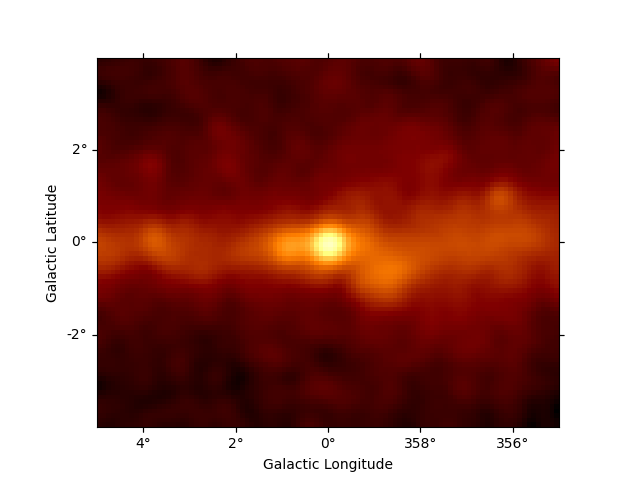
interactive(children=(SelectionSlider(continuous_update=False, description='Select energy_true:', layout=Layout(width='50%'), options=('3.98 GeV - 5.01 GeV', '5.01 GeV - 6.31 GeV', '6.31 GeV - 7.94 GeV', '7.94 GeV - 10.0 GeV', '10.0 GeV - 12.6 GeV', '12.6 GeV - 15.8 GeV', '15.8 GeV - 20.0 GeV', '20.0 GeV - 25.1 GeV', '25.1 GeV - 31.6 GeV', '31.6 GeV - 39.8 GeV', '39.8 GeV - 50.1 GeV', '50.1 GeV - 63.1 GeV', '63.1 GeV - 79.4 GeV', '79.4 GeV - 100 GeV', '100 GeV - 126 GeV', '126 GeV - 158 GeV', '158 GeV - 200 GeV', '200 GeV - 251 GeV', '251 GeV - 316 GeV', '316 GeV - 398 GeV', '398 GeV - 501 GeV', '501 GeV - 631 GeV', '631 GeV - 794 GeV', '794 GeV - 1 TeV', '1 TeV - 1.26 TeV', '1.26 TeV - 1.58 TeV', '1.58 TeV - 2.00 TeV', '2.00 TeV - 2.51 TeV'), style=SliderStyle(description_width='initial'), value='3.98 GeV - 5.01 GeV'), RadioButtons(description='Select stretch:', index=1, options=('linear', 'sqrt', 'log'), style=DescriptionStyle(description_width='initial'), value='sqrt'), Output()), _dom_classes=('widget-interact',))
PSF#
For Fermi-LAT, the PSF only varies little within a given regions of the sky, especially at high energies like what we have here. So we have only one PSF kernel.
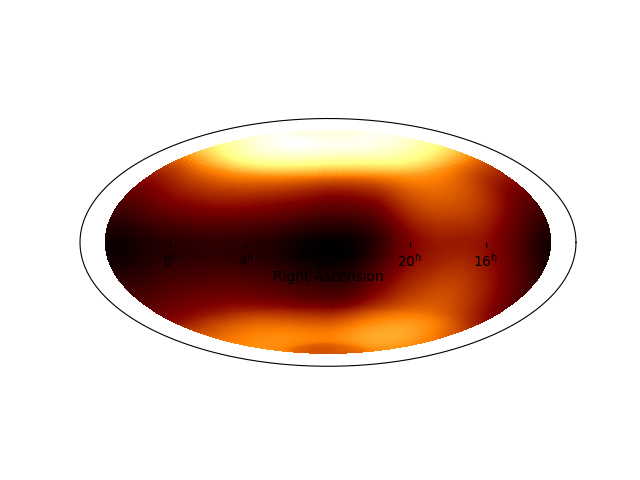
Region of interest and mask definition#
As mentioned previously, the width of dataset is larger that our actual
region of interest in order to properly take into account for the
sources outside that contributes inside due to the PSF. So we define the
valid RoI for fitting by creating a mask_fit.
margin = (
2.0 * u.deg
) # >1 deg should be fine for this dataset we take 2 so the notebook is faster
geom = datasets[0].counts.geom
mask_fit = Map.from_geom(geom, data=True, dtype=bool)
mask_fit = mask_fit.binary_erode(width=margin, kernel="disk")
mask_fit.plot_interactive()
plt.show()
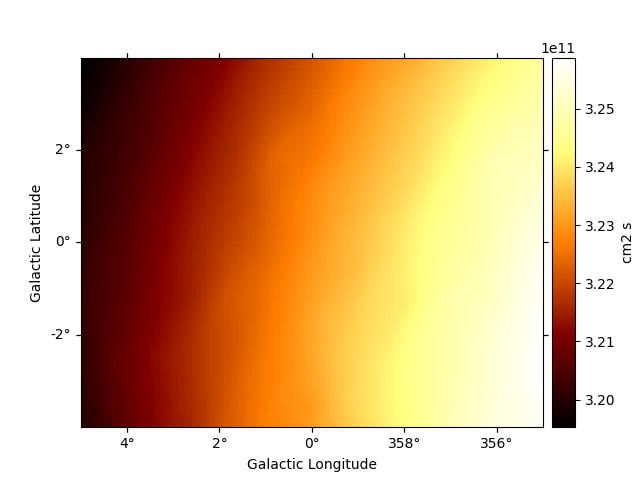
interactive(children=(SelectionSlider(continuous_update=False, description='Select energy:', layout=Layout(width='50%'), options=('10.0 GeV - 12.6 GeV', '12.6 GeV - 15.8 GeV', '15.8 GeV - 20.0 GeV', '20.0 GeV - 25.1 GeV', '25.1 GeV - 31.6 GeV', '31.6 GeV - 39.8 GeV', '39.8 GeV - 50.1 GeV', '50.1 GeV - 63.1 GeV', '63.1 GeV - 79.4 GeV', '79.4 GeV - 100 GeV', '100 GeV - 126 GeV', '126 GeV - 158 GeV', '158 GeV - 200 GeV', '200 GeV - 251 GeV', '251 GeV - 316 GeV', '316 GeV - 398 GeV', '398 GeV - 501 GeV', '501 GeV - 631 GeV', '631 GeV - 794 GeV', '794 GeV - 1 TeV'), style=SliderStyle(description_width='initial'), value='10.0 GeV - 12.6 GeV'), RadioButtons(description='Select stretch:', index=1, options=('linear', 'sqrt', 'log'), style=DescriptionStyle(description_width='initial'), value='sqrt'), Output()), _dom_classes=('widget-interact',))
Now we attach it the datasets
for d in datasets:
d.mask_fit = mask_fit
Models#
Isotropic diffuse background#
The FermipyDatasetsReader also created one isotropic diffuse model
for each dataset:
models_iso = Models(datasets.models)
print(models_iso)
Models
Component 0: SkyModel
Name : isotropic_P8R3_CLEAN_V3_PSF2_v1
Datasets names : ['P8R3_CLEAN_V3_PSF2_v1']
Spectral model type : CompoundSpectralModel
Spatial model type : ConstantSpatialModel
Temporal model type :
Parameters:
tilt (frozen): 0.000
norm : 1.000 +/- 0.00
reference (frozen): 1.000 TeV
value (frozen): 1.000 1 / sr
Component 1: SkyModel
Name : isotropic_P8R3_CLEAN_V3_PSF3_v1
Datasets names : ['P8R3_CLEAN_V3_PSF3_v1']
Spectral model type : CompoundSpectralModel
Spatial model type : ConstantSpatialModel
Temporal model type :
Parameters:
tilt (frozen): 0.000
norm : 1.000 +/- 0.00
reference (frozen): 1.000 TeV
value (frozen): 1.000 1 / sr
Galactic diffuse background#
The Fermi-LAT collaboration provides a galactic diffuse emission model,
that can be used as a background model for Fermi-LAT source analysis.
These files are called usually IEM for interstellar emission model, the
latest is
gll_iem_v07.fits.
For details see the BackgroundModels
page.
If you have Fermipy installed it can also be found in
$FERMI_DIR/refdata/fermi/galdiffuse/gll_iem_v07.fits
Diffuse model maps are very large (100s of MB), so as an example here, we just load one that represents a small cutout for the Galactic center region.
In this case, the maps are already in differential units, so we do not want to normalise it again.
template_iem = TemplateSpatialModel.read(
filename="$GAMMAPY_DATA/fermi-gc/gll_iem_v07_gc.fits.gz", normalize=False
)
model_iem = SkyModel(
spectral_model=PowerLawNormSpectralModel(),
spatial_model=template_iem,
name="diffuse-iem",
)
Let’s look at the template :
template_iem.map.plot_interactive(add_cbar=True)
plt.show()
models_diffuse = models_iso + model_iem
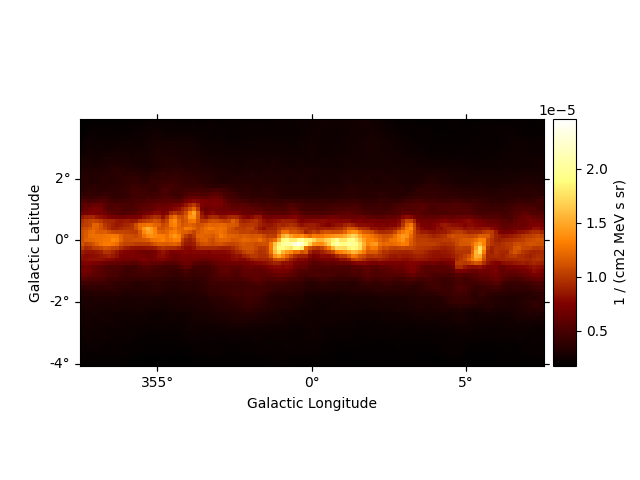
interactive(children=(SelectionSlider(continuous_update=False, description='Select energy_true:', layout=Layout(width='50%'), options=('50.0 MeV', '65.0 MeV', '84.5 MeV', '110 MeV', '143 MeV', '185 MeV', '241 MeV', '313 MeV', '407 MeV', '529 MeV', '687 MeV', '893 MeV', '1.16 GeV', '1.51 GeV', '1.96 GeV', '2.55 GeV', '3.31 GeV', '4.31 GeV', '7.27 GeV', '12.3 GeV', '20.8 GeV', '35.0 GeV', '59.2 GeV', '100.0 GeV', '169 GeV', '285 GeV', '482 GeV', '814 GeV'), style=SliderStyle(description_width='initial'), value='50.0 MeV'), RadioButtons(description='Select stretch:', index=1, options=('linear', 'sqrt', 'log'), style=DescriptionStyle(description_width='initial'), value='sqrt'), Output()), _dom_classes=('widget-interact',))
Sources#
Source models can be loaded from the 4FGL catalog directly available in
$GAMMAPY_DATA. For details see the Fermi-LAT catalog
page.
catalog_4fgl = CATALOG_REGISTRY.get_cls("4fgl")() # load 4FGL catalog
We want to select only the sources inside the dataset spatial geometry:
/home/runner/work/gammapy-docs/gammapy-docs/gammapy/.tox/build_docs/lib/python3.11/site-packages/gammapy/catalog/fermi.py:587: UserWarning: Warning: converting a masked element to nan.
"index_2": np.nan_to_num(float(self.data["Unc_PLEC_Exp_Index"])),
/home/runner/work/gammapy-docs/gammapy-docs/gammapy/.tox/build_docs/lib/python3.11/site-packages/gammapy/catalog/fermi.py:587: UserWarning: Warning: converting a masked element to nan.
"index_2": np.nan_to_num(float(self.data["Unc_PLEC_Exp_Index"])),
/home/runner/work/gammapy-docs/gammapy-docs/gammapy/.tox/build_docs/lib/python3.11/site-packages/gammapy/catalog/fermi.py:587: UserWarning: Warning: converting a masked element to nan.
"index_2": np.nan_to_num(float(self.data["Unc_PLEC_Exp_Index"])),
That’s still quite a lot of sources
print("Number of source models", len(models_4fgl_gc))
Number of source models 110
In order to improve performances we can store all the sources outside
the mask_fit region into a single template (the same could be done
for all the sources we want to keep frozen).
sources_ouside_roi = models_4fgl_gc.select_mask(~mask_fit, use_evaluation_region=False)
sources_inside_roi = Models([m for m in models_4fgl_gc if m not in sources_ouside_roi])
geom_true = datasets[0].exposure.geom
sources_outside_roi = sources_ouside_roi.to_template_sky_model(
geom_true, name="sources_outside"
)
sources_outside_roi.spatial_model.filename = "sources_outside.fits"
sources_outside_roi.spatial_model.map.plot_interactive(add_cbar=True)
plt.show()
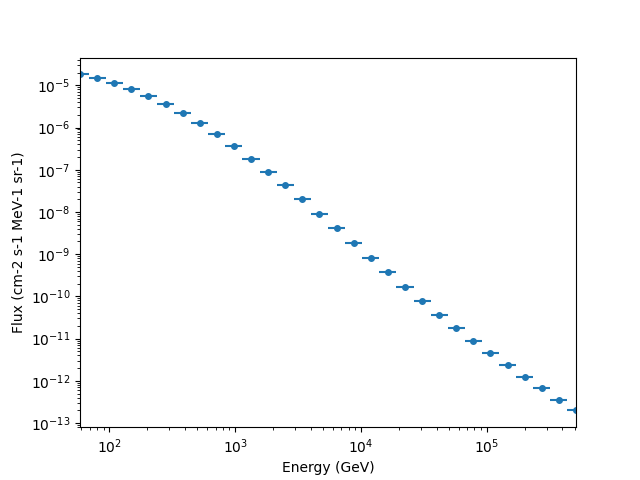
interactive(children=(SelectionSlider(continuous_update=False, description='Select energy_true:', layout=Layout(width='50%'), options=('3.98 GeV - 5.01 GeV', '5.01 GeV - 6.31 GeV', '6.31 GeV - 7.94 GeV', '7.94 GeV - 10.0 GeV', '10.0 GeV - 12.6 GeV', '12.6 GeV - 15.8 GeV', '15.8 GeV - 20.0 GeV', '20.0 GeV - 25.1 GeV', '25.1 GeV - 31.6 GeV', '31.6 GeV - 39.8 GeV', '39.8 GeV - 50.1 GeV', '50.1 GeV - 63.1 GeV', '63.1 GeV - 79.4 GeV', '79.4 GeV - 100 GeV', '100 GeV - 126 GeV', '126 GeV - 158 GeV', '158 GeV - 200 GeV', '200 GeV - 251 GeV', '251 GeV - 316 GeV', '316 GeV - 398 GeV', '398 GeV - 501 GeV', '501 GeV - 631 GeV', '631 GeV - 794 GeV', '794 GeV - 1 TeV', '1 TeV - 1.26 TeV', '1.26 TeV - 1.58 TeV', '1.58 TeV - 2.00 TeV', '2.00 TeV - 2.51 TeV'), style=SliderStyle(description_width='initial'), value='3.98 GeV - 5.01 GeV'), RadioButtons(description='Select stretch:', index=1, options=('linear', 'sqrt', 'log'), style=DescriptionStyle(description_width='initial'), value='sqrt'), Output()), _dom_classes=('widget-interact',))
Now we have less models to describe the sources
models_sources = sources_inside_roi + sources_outside_roi
print("Number of source models", len(models_sources))
Number of source models 28
Fit#
Now, the big finale: let’s do a 3D of the brightest sources and IEM models.
First we attach the models to the datasets.
models = models_sources + models_diffuse
datasets.models = models
print("Number of models", len(models))
Number of models 31
Let’s find the 3 brightest sources:
n_brightest = 3
integrated_flux = u.Quantity(
[m.spectral_model.integral(10 * u.GeV, 1 * u.TeV) for m in sources_inside_roi]
)
order = np.argsort(integrated_flux)
selected_sources = Models([sources_inside_roi[int(ii)] for ii in order[:n_brightest]])
print(selected_sources.names)
free_models = selected_sources + model_iem
['4FGL J1739.4-3015', '4FGL J1751.6-3002', '4FGL J1754.3-2915']
We keep only their normalisation free for simplicity:
models.freeze() # freeze all parameters
# and unfreeze only the amplitude or norm of the selected models
for p in free_models.parameters:
if p.name in ["amplitude", "norm"]:
p.frozen = False
p.min = 0
print("Number of free parameters", len(models.parameters.free_parameters))
fit = Fit()
result = fit.run(datasets=datasets)
print(result)
Number of free parameters 4
OptimizeResult
backend : minuit
method : migrad
success : True
message : Optimization terminated successfully.
nfev : 97
total stat : 20322.54
CovarianceResult
backend : minuit
method : hesse
success : True
message : Hesse terminated successfully.
Residual TS map#
Now we can look at the residual TS map to check there is no significant excess left:
spatial_model = PointSpatialModel()
spectral_model = PowerLawSpectralModel(index=2)
model = SkyModel(spatial_model=spatial_model, spectral_model=spectral_model)
ts_estimator = TSMapEstimator(
model,
kernel_width="1 deg", # this set close to the 95-99% containment radius of the PSF
selection_optional=[],
sum_over_energy_groups=True,
energy_edges=[10, 1000] * u.GeV,
)
ts_results = ts_estimator.run(datasets)
image = ts_results["sqrt_ts"]
image = image.cutout(
image.geom.center_skydir, width=np.max(image.geom.width) - 2 * margin
)
fig = plt.figure(figsize=(7, 5))
ax = image.plot(
clim=[-8, 8],
cmap=plt.cm.RdBu_r,
add_cbar=True,
kwargs_colorbar={"label": r"$\sqrt{TS}$ [$\sigma$]"},
)
sources_inside_roi.plot_regions(
ax=ax, edgecolor="g", linestyle="-", kwargs_point=dict(marker=".")
)
plt.show()
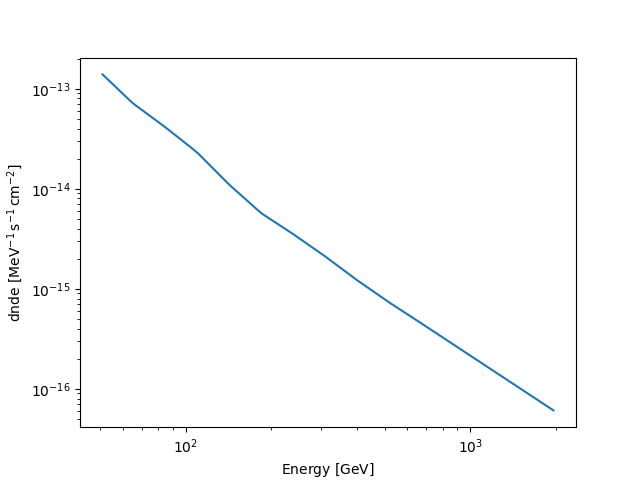
Serialisation#
To serialise the created dataset, you must proceed through the Datasets API
datasets.write(
filename="fermi_lat_gc_datasets.yaml",
filename_models="fermi_lat_gc_models.yaml",
overwrite=True,
)
datasets_read = Datasets.read(
filename="fermi_lat_gc_datasets.yaml", filename_models="fermi_lat_gc_models.yaml"
)
Exercises#
Fit the position and spectrum of the source SNR G0.9+0.1.
Make maps and fit the position and spectrum of the Crab nebula.
Summary#
In this tutorial you have seen how to work with Fermi-LAT data with Gammapy. You have to use Fermipy or the Fermi ST to perform the data reduction then you can use Gammapy for analysis using the same methods that are used to analyse IACT data.
Total running time of the script: (0 minutes 25.018 seconds)
